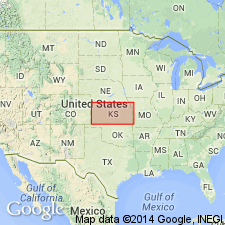
- Usage in publication:
-
- Dennis limestone*
- Modifications:
-
- Original reference
- Dominant lithology:
-
- Limestone
- AAPG geologic province:
-
- Cherokee basin
Summary:
Pg. 36. Dennis limestone. Fossiliferous limestone, 10 to 20 feet thick, varying from heavy-bedded to thin-bedded, with shale partings. Overlies Galesburg shales and underlies Cherryvale shales. Age is Pennsylvanian. Report includes geologic map.
Named from exposures at RR station at Dennis, Labette Co., KS.
Source: US geologic names lexicon (USGS Bull. 896, p. 597); supplemental information from GNU records (USGS DDS-6; Denver GNULEX).

- Usage in publication:
-
- Dennis limestone*
- Modifications:
-
- Overview
- AAPG geologic province:
-
- Cherokee basin
Summary:
In 1912 the equivalency of Dennis limestone of Adams (1903) with Winterset limestone of Bain (1896) was regarded, by E. Haworth, F.C. Greene, and other geologists, as established. The name Winterset having priority, Dennis limestone was discarded by the USGS, and Winterset limestone was adopted for the limestone underlying Cherryvale shale and overlying Galesburg shale. This usage was followed by the USGS and the Kansas Geological Survey until 1932, when R.C. Moore revived Dennis, as explained [under the Moore (1932) entry].
Source: US geologic names lexicon (USGS Bull. 896, p. 597).
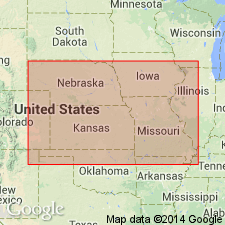
- Usage in publication:
-
- Dennis formation
- Modifications:
-
- Overview
- AAPG geologic province:
-
- Cherokee basin
Summary:
Pg. 102. Dennis formation. Includes Canville limestone, Stark shale, and Winterset limestone, all of which are present near Dennis, in northeast part of Labette County, Kansas. Age is Pennsylvanian.
Source: US geologic names lexicon (USGS Bull. 896, p. 597).
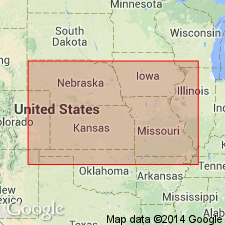
- Usage in publication:
-
- Dennis formation
- Modifications:
-
- Reinstated
- Revised
- Dominant lithology:
-
- Limestone
- Shale
- AAPG geologic province:
-
- Cherokee basin
Summary:
Pg. 91, 97. Dennis formation of Bronson group [also referred to as Dennis limestone]. Dennis formation underlies Cherryvale shale, overlies Galesburg shale, and includes (descending) Winterset limestone, Stark shale, and Canville limestone members. The Canville limestone is a thin blue bed which has typical "middle" characteristics. The overlying Stark shale is a black, fissile shale. The Winterset limestone is same as previously recognized in Kansas and Missouri. Because the Canville and Stark evidently belong with the Winterset, as part of another sedimentation cycle, these terms are combined under name Dennis formation, a name used in early Kansas reports to include these strata. The so-called Galesburg shale of Kansas City area is mainly Stark shale. Age is Late Pennsylvanian (Missouri age).
Source: US geologic names lexicon (USGS Bull. 896, p. 597); GNC KS-NE Pennsylvanian Corr. Chart, sheet 2, Oct. 1936.
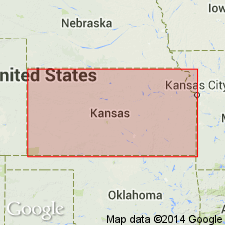
- Usage in publication:
-
- Dennis formation
- Modifications:
-
- Overview
- AAPG geologic province:
-
- Cherokee basin
Summary:
Dennis formation. Adopted revised definition [of Moore, 1932].
Source: US geologic names lexicon (USGS Bull. 896, p. 597).
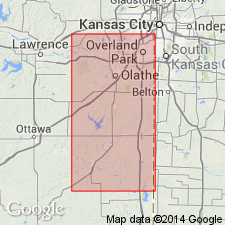
- Usage in publication:
-
- Dennis formation
- Modifications:
-
- Revised
- AAPG geologic province:
-
- Forest City basin
Summary:
Pg. 30, 32, 36. Dennis formation. Type Dennis includes more than Winterset limestone. The Canville limestone and overlying black Stark shale [4 to 7 feet] lie at horizon of upper part of so-called Galesburg shale of Kansas City region. According to Jewett they both are present at both Galesburg and Dennis. The older writers did not mention any limestone or black shale, in the type Galesburg, and it is almost certain they were grouped with the overlying main limestone under the name Dennis, in which they are included in this report.
See also R.C. Moore (1936) entry under Galesburg shale.
Source: US geologic names lexicon (USGS Bull. 896, p. 597); GNC KS-NE Pennsylvanian Corr. Chart, sheet 2, Oct. 1936.
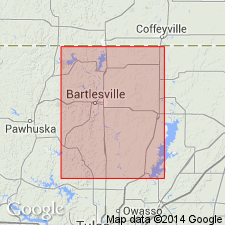
- Usage in publication:
-
- Dennis limestone
- Modifications:
-
- Not used
- AAPG geologic province:
-
- Chautauqua platform
Summary:
Pg. 723-724. Dennis limestone. Abandoned in Oklahoma in favor of Hogshooter limestone.
Source: US geologic names lexicon (USGS Bull. 1200, p. 1090-1091).
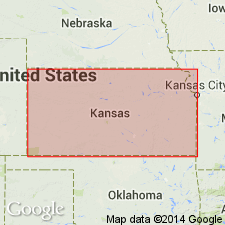
- Usage in publication:
-
- Dennis limestone
- Modifications:
-
- Revised
Summary:
Pg. 191-192. Dennis limestone. Included in Bronson group. Comprises (ascending) Canville limestone, Stark shale, and Winterset limestone members. Overlies Galesburg shale; underlies Fontana shale. Age is Late Pennsylvanian (Missourian).
Source: US geologic names lexicon (USGS Bull. 1200, p. 1090-1091).
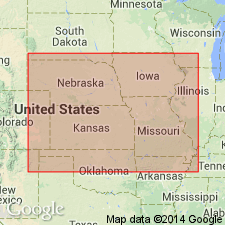
- Usage in publication:
-
- Dennis formation
- Modifications:
-
- Revised
- AAPG geologic province:
-
- Forest City basin
Summary:
Pg. 2031 (fig. 4). Dennis formation. Included in Bronson subgroup [informal] of Kansas City group. Comprises Canville limestone, Stark shale, and Winterset limestone members. Overlies Galesburg formation; underlies Cherryvale formation. Age is Late Pennsylvanian (Missourian).
["Subgroup" not recognized as a formal stratigraphic rank term (CSN, 1933; ACSN, 1961, 1970; NACSN, 1983, 2005, 2021). Considered informal and should not be capitalized.]
Source: US geologic names lexicon (USGS Bull. 1200, p. 1090-1091).
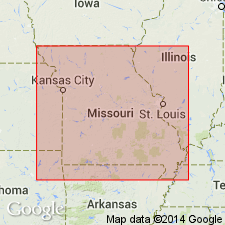
- Usage in publication:
-
- Dennis formation
- Modifications:
-
- Revised
Summary:
Pg. 11-12. Dennis formation. Redefined for Missouri to include Canville, Stark, and Winterset members. Age is Late Pennsylvanian (Missourian).
Source: US geologic names lexicon (USGS Bull. 1200, p. 1090-1091).
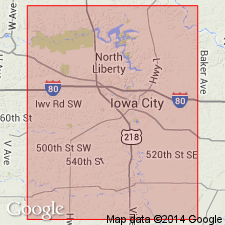
- Usage in publication:
-
- Dennis formation
- Modifications:
-
- Areal extent
- AAPG geologic province:
-
- Iowa shelf
Summary:
Pg. 421. Dennis formation. Thickness of formation in Madison County, Iowa, about 23 feet. Includes Canville, Stark, and Winterset members. Overlies Galesburg shale; underlies Cherryvale formation. Age is Late Pennsylvanian (Missourian).
Source: US geologic names lexicon (USGS Bull. 1200, p. 1090-1091).
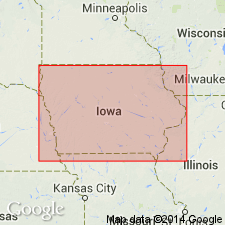
- Usage in publication:
-
- Dennis formation
- Modifications:
-
- Areal extent
Summary:
Pg. 27, fig. 5. Dennis limestone of Kansas City group. Comprises (ascending) Canville limestone, Stark shale, and Winterset limestone members. Canville usually missing in Iowa sections. Underlies Cherryvale shale; overlies Galesburg shale. Age is Late Pennsylvanian (Missourian).
Source: US geologic names lexicon (USGS Bull. 1200, p. 1090-1091).
For more information, please contact Nancy Stamm, Geologic Names Committee Secretary.
Asterisk (*) indicates published by U.S. Geological Survey authors.
"No current usage" (†) implies that a name has been abandoned or has fallen into disuse. Former usage and, if known, replacement name given in parentheses ( ).
Slash (/) indicates name conflicts with nomenclatural guidelines (CSN, 1933; ACSN, 1961, 1970; NACSN, 1983, 2005, 2021). May be explained within brackets ([ ]).

